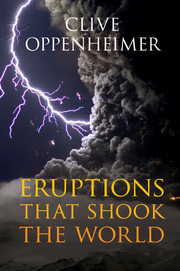Book contents
- Frontmatter
- Contents
- Preface
- Acknowledgements
- 1 Fire and brimstone: how volcanoes work
- 2 Eruption styles, hazards and ecosystem impacts
- 3 Volcanoes and global climate change
- 4 Forensic volcanology
- 5 Relics, myths and chronicles
- 6 Killer plumes
- 7 Human origins
- 8 The ash giant/sulphur dwarf
- 9 European volcanism in prehistory
- 10 The rise of Teotihuacán
- 11 Dark Ages: dark nature?
- 12 The haze famine
- 13 The last great subsistence crisis in the Western world
- 14 Volcanic catastrophe risk
- Appendix A Large eruptions
- Appendix B Further reading and data sources
- References
- Index
1 - Fire and brimstone: how volcanoes work
Published online by Cambridge University Press: 01 June 2011
- Frontmatter
- Contents
- Preface
- Acknowledgements
- 1 Fire and brimstone: how volcanoes work
- 2 Eruption styles, hazards and ecosystem impacts
- 3 Volcanoes and global climate change
- 4 Forensic volcanology
- 5 Relics, myths and chronicles
- 6 Killer plumes
- 7 Human origins
- 8 The ash giant/sulphur dwarf
- 9 European volcanism in prehistory
- 10 The rise of Teotihuacán
- 11 Dark Ages: dark nature?
- 12 The haze famine
- 13 The last great subsistence crisis in the Western world
- 14 Volcanic catastrophe risk
- Appendix A Large eruptions
- Appendix B Further reading and data sources
- References
- Index
Summary
‘Some volcanos are in a state of incessant eruption; some, on the contrary, remain for centuries in a condition of total outward inertness, and return again to the same state of apparent extinction after a single vivid eruption of short duration; while others exhibit an infinite variety of phases intermediate between the extreme of vivacity and sluggishness.’
G. P. Scrope, Volcanos (1862) [1]The Earth is cooling down! This has nothing to do with contemporary global warming of the atmosphere and surface. I refer instead to the Earth's interior – the source of the molten rocks erupted by volcanoes throughout the planet's 4.567 billion year history. Aeons before the continents drifted to anything like their familiar positions, and as early as 3.34 billion years ago, parts of the Earth were already colonised by primitive bacterial life forms. At this time, volcanoes erupted lavas with a much higher content of an abundant green mineral called olivine than found in most modern volcanic rocks. This testifies to much higher eruption temperatures for the ancient lavas compared with present-day eruptions from Mt Etna or the Hawaiian volcanoes. In turn, it reveals that the Earth's largest internal shell, the olivine-rich mantle, which comprises about 84% of the Earth's volume, used to be considerably hotter, too (anywhere between 100 and 500 °C depending on whom you believe).
- Type
- Chapter
- Information
- Eruptions that Shook the World , pp. 1 - 21Publisher: Cambridge University PressPrint publication year: 2011



